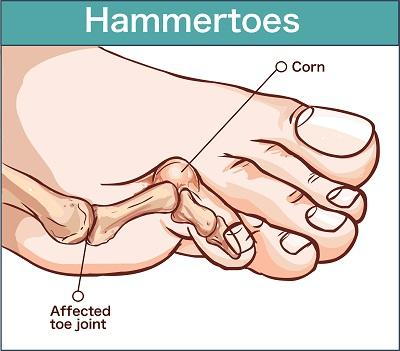What are Hammertoes?
- posted: Jul. 03, 2019
A hammertoe is a common foot deformity that affects the middle joint of the smaller toes. As a result, this causes the toes to bend downward. Since this bend causes the joint to stick out this can put more pressure on the affected joints when wearing shoes, which can also make the deformity worse over time. As with most foot deformities a hammertoe will start out minor and continue to progress over time if left untreated.
During the earlier stages you may not notice much pain and discomfort. In fact the only way you may be able to tell that you have a hammertoe is by examining the foot and noticing that the small toes bend downward like a claw. Of course, at this stage the deformed joint is still flexible enough to be straightened out.
However, if the deformity progresses this can cause the joint to become rigid, which won’t respond effectively to simple conservative treatments. As you might imagine, the sooner you see a podiatrist to treat your hammertoe the better. Early intervention is key, as a hammertoe will not get better without the proper care.
Hammertoes are often the result of an imbalance in the muscle or tendon of the foot. Over time, this leads to structural changes in the foot. Genetics may also play a role in whether your feet are at risk for this deformity. A hammertoe can also be made worse by wearing shoes that are too tight and put too much pressure on the toes.
Along with the structural changes that occur with hammertoes it’s also common to experience redness, inflammation or the development of a corn or callus on the toe. If you are noticing symptoms of a hammertoe see your podiatrist for an evaluation. A simple physical exam is usually all that’s needed to diagnose a hammertoe; however, sometimes an x-ray will be performed in order to determine the extent of the deformity.
If you are dealing with a flexible hammertoe, more often than not simple nonsurgical treatment options are all that’s needed. Following simple treatment options and care can prevent the hammertoes from becoming rigid or painful. Some nonsurgical treatment options include:
- Wearing the appropriate footwear. This means wearing shoes that aren’t pointy or have high heels, which can put more pressure on the toes.
- Placing custom orthotics into your shoes, which can ease discomfort and prevent pain resulting in a muscular imbalance.
- Taking over-the-counter pain relievers such as ibuprofen, which can reduce both pain and inflammation.
- Splinting the toe or toes to keep them straight, which can also reduce stiffness, inflammation and pain.
- Applying protective non-medicated padding over the top of the toe to prevent a corn or callus from developing.
If your hammertoe is painful or rigid then you may need to discuss whether surgery is the best option for alleviating your symptom and correcting the deformity. If you are dealing with a hammertoe turn to a foot specialist for help.
